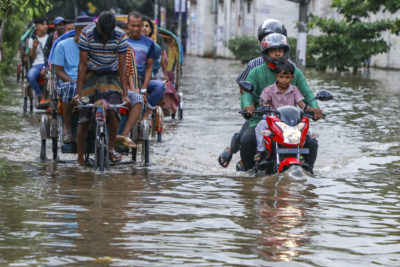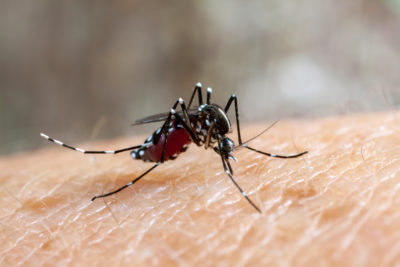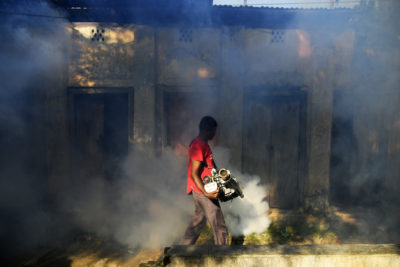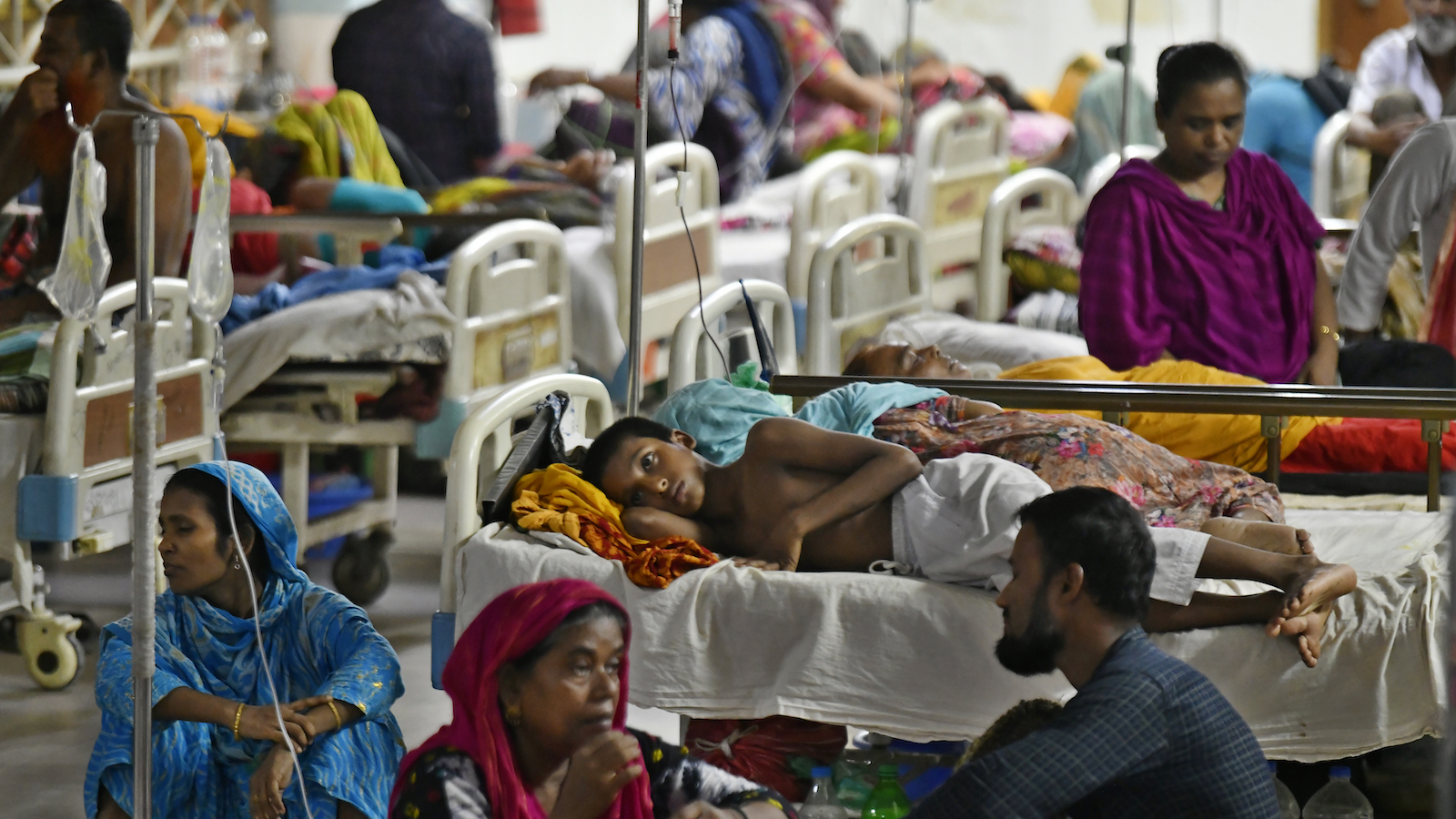The monsoon season in Bangladesh usually runs from Could to September, with rainfall peaking in July and sputtering out in early October. This 12 months, nonetheless, there was extra rain than traditional in October and even some showers in usually dry November. The additional rain, together with general hotter temperatures, contributed to a surge in instances of dengue fever, prolonging the nation’s largest and deadliest recorded outbreak of the mosquito-borne illness.
In line with knowledge from Bangladesh’s ministry of well being, 1,570 folks have died and greater than 300,000 have been contaminated as of November 22. That’s 3 times the variety of infections recorded within the nation’s largest earlier outbreak, in 2019.
Dengue is a viral an infection transmitted to people by the chunk of contaminated Aedes aegypti or Aedes albopictus mosquitoes. The illness is usually known as “breakbone fever” for the aches and pains it may produce. Whereas most instances of dengue are comparatively delicate, and signs may be handled, some sufferers develop dengue hemorrhagic fever, which may be deadly.
A World Well being Group official known as latest dengue outbreaks a “canary within the coal mine of the local weather disaster.”
This 12 months’s dengue outbreaks haven’t been restricted to Bangladesh. Greater than 4.5 million instances and 4,000 deaths associated to dengue have been reported this 12 months, by means of the start of November, from 80 international locations. Greater than half of these instances have been in South America, with epidemics in Brazil, Peru, and Bolivia, however there have been additionally outbreaks in South and Southeast Asian international locations, together with Sri Lanka, Thailand, and Vietnam.
Dengue infections have been rising in tropical and subtropical areas for the previous twenty years: Instances reported to the World Well being Group (WHO) elevated from about half 1,000,000 in 2000 to five.2 million in 2019. Improved diagnostics and reporting clarify a lot of this bounce, however a mixture of inhabitants development, growing urbanization and journey, and climatic adjustments can also be boosting Aedes mosquitoes, which drives up transmission in present hotspots and spreads it towards new areas at each larger latitudes and better altitudes. In recent times, dengue has popped up in locations it had by no means been seen, together with Afghanistan, components of Southern Europe, and, this 12 months, Chad.
In July, a senior WHO official flagged the position of rising temperatures and humidity ranges — along with this 12 months’s El Niño — calling the outbreaks a “canary within the coal mine of the local weather disaster.” About half the world’s inhabitants is already uncovered to dengue danger; a 2019 local weather modelling research projected that beneath a average warming state of affairs, an extra 2 billion folks can be prone to dengue publicity by 2080, in comparison with 2015.

Flooding after heavy rains in Dhaka, September 22, 2023.
Kazi Salahuddin Razu / NurPhoto by way of AP
Bangladesh’s disaster is thus “a wake-up name,” particularly for South Asia, stated Ayesha Mahmud, a well being demographer specializing in infectious illness on the College of California, Berkeley. “Understanding the affect of those drivers of dengue transmission might be essential for forecasting outbreaks sooner or later,” she added, “significantly within the context of predicted climatic adjustments, similar to will increase in imply temperatures throughout the tropics and the intensification of the monsoon season.”
A warming and urbanizing world has been good for A. aegypti, the primary vector of the dengue virus. In line with the 2020 Lancet Countdown on Well being and Local weather Change, rising world temperatures between 1950 and 2018 elevated the local weather suitability for the transmission of the dengue virus by virtually 9 p.c for A. aegypti and 15 p.c for A. albopictus.
As temperatures proceed to rise, extra areas will develop into liveable for these mosquitoes. “Sooner or later, the belt of transmission goes to proceed increasing northwards and upwards,” stated Felipe Colón-González, a local weather and well being knowledgeable on the Wellcome Belief, a world charitable basis primarily based within the U.Okay. “There’s going to be extra months which can be going to be appropriate for transmission, and since individuals are prone to journey extra, there’s additionally going to be extra alternatives for shifting the mosquitoes and shifting the illness to completely different areas.”
In Bangladesh, dengue season may develop into longer as winter temperatures rise, resulting in outbreaks at any time of the 12 months.
The most important improve in instances, stated Colón-González, is predicted in Southeast Asia — particularly components of Malaysia, Indonesia, the Philippines, Vietnam, and a few areas of the Indian subcontinent — and in South America, significantly Brazil. Though inhabitants development and urbanization will play greater roles in boosting danger, larger temperatures can improve mosquito inhabitants density, their biting price, and even their flying distances, research have proven.
In higher-warming situations, nonetheless, some areas in India, Bangladesh, and Thailand, amongst others, may develop into much less appropriate for A. aegypti, leading to a decline in instances within the second half of the century, in response to Colón-González’s local weather modeling. The optimum temperature vary for Aedes mosquitoes is regarded as 77 to 86 levels F (25 to 30 levels C).
Consultants additionally anticipate extra instances in components of Africa, although projections for that area are tough to make as a result of lack of well being knowledge. Areas unfamiliar with dengue could also be exhausting hit even when case numbers aren’t excessive, Colón-González warns, as folks gained’t have immunity from earlier publicity to the virus, and public well being techniques might not be robust sufficient to deal with dengue outbreaks. Even the place well being techniques are robust, similar to in Southern Europe or the US — which has recorded 1,874 instances in 2023, as of November 8 — docs could not have the ability to establish the illness. “Well being care suppliers ought to study to acknowledge this illness at an early stage,” says the Facilities for Illness Management and Prevention.

Aedes aegypti punctures human pores and skin, drawing blood.
Tacio Philip Sansonovski / Alamy Inventory Picture
Hotter temperatures may additionally develop the season for transmission. A 2021 research exploring future danger for Bangladesh discovered that the dengue season may develop into longer as winter temperatures rise, resulting in “outbreaks occurring at any time of the 12 months.”
Adjustments in rainfall may also form outbreak danger, as Bangladesh noticed this 12 months. Elevated rain means there’s extra stagnant water by which mosquitoes can breed, although deluges may also wash larvae away. And diminished rainfall can lead communities to retailer water, which creates alternatives for mosquitoes to breed. Researchers have additionally linked El Niño, a local weather phenomenon that brings heavy rain to some locations, with elevated incidence of dengue in Colombia and with outbreaks in Venezuela.
Dengue is usually thought of an city illness as a result of A. aegypti thrives in cities, breeding even in tiny quantities of water and feeding on a big human inhabitants. Nonetheless, a latest research by Colón-González and others transmission dynamics in Southeast Asia discovered that densely populated city areas could also be at decrease danger in comparison with surrounding or growing rural areas, maybe as a result of extremely developed cities are prone to be wealthier and have higher infrastructure — from trash assortment to water entry — than newly urbanizing areas.
Being contaminated with one pressure of dengue doesn’t present immunity to others, and a second an infection may cause extra extreme illness.
Within the research, larger GDP turned out to have a protecting impact towards dengue. Colón-González factors to the distinction in dengue incidence in cities on both facet of the U.S.-Mexico border. “The variety of instances on the Mexican facet is greater than 100 occasions greater than on the U.S. facet, even when they share the identical local weather,” he stated. “Folks [in the U.S.] have extra adaptive capability. They’ve entry to air-con, [which] reduces humidity and temperature and the survival of mosquitoes.”
A post-pandemic improve in development exercise can also be taking part in a job within the Bangladesh outbreaks, stated Kabirul Bashar, an entomologist and a member of the federal government anti-dengue committee, as a result of stagnant water can gather within the trenches and shafts of constructing websites. Fast and unplanned urbanization additionally implies that many areas don’t have an everyday water provide, forcing folks to retailer water, he famous. These areas could not have correct waste administration techniques both, resulting in massive portions of litter that gather water in shut proximity to houses. Within the capital of Dhaka, as an illustration, analysis has discovered mosquitoes breeding in all the pieces from discarded tires and fridge trays to plastic drums and development waste.

A employee sprays insecticide in a crowded neighborhood in Dhaka to guard towards dengue fever, July 18, 2023.
Syed Mahamudur Rahman / NurPhoto by way of Getty Pictures
Current years have additionally seen extra instances reported from past Bangladesh’s capital area. In 2023, instances have been reported from each district within the nation, with extra instances outdoors Dhaka than inside. The spatial enlargement can also assist clarify the upper demise toll, as beforehand unexposed populations get contaminated in areas with out satisfactory well being infrastructure.
The demise toll can also be defined by the presence of 4 completely different serotypes, or strains, of the dengue virus circulating within the area. Since 2019, the dominant pressure of dengue in Bangladesh has been DENV-3. However DENV-4 emerged in final 12 months’s outbreak, and the extremely virulent DENV-2 is reported to have dominated instances this 12 months, after a hiatus of 4 years. Being contaminated with one pressure doesn’t present immunity to others, and a second an infection may cause extra extreme illness, elevating the danger of demise. “When a brand new serotype is launched in a inhabitants that beforehand skilled epidemics of different serotypes, we would see worse outcomes and extra extreme instances within the inhabitants,” stated Mahmud, of UC Berkeley.
The big outbreaks lately could have their very own knock-on impact. “The evolution of the virus occurs sooner when there’s huge unfold and new serotypes [emerge], which in flip results in huge endemic outbreaks,” says Neelika Malavige, world head of the dengue program on the nonprofit Medication for Uncared for Ailments initiative (DNDi).
Pesticides may be useful, however research have discovered that many mosquitoes in Dhaka have develop into proof against generally used pesticides.
Researchers are ramping up their efforts to search out options. Historically, communities have centered on vector management — lowering the probabilities of a mosquito chunk by selling using window screens and mattress nets or attempting to eradicate mosquitoes totally with insecticide sprays. However as a result of Aedes is energetic through the day — in contrast to the malaria-carrying Anopheles — mattress nets are of restricted use, specialists notice. Spraying pesticides on breeding websites may be useful, stated Bashar, however research have discovered many mosquitoes in Dhaka have develop into proof against generally used pesticides. He believes higher waste disposal and common water provide are crucial to lowering mosquito breeding.
From a well being perspective, specialists say improved illness surveillance and public well being infrastructure might be wanted to detect instances early. In recent times, researchers have been attempting out early warning techniques to forecast outbreaks utilizing fashions that combine components like rainfall and inhabitants density. Such a system has been tried with some success in Colombia; Colón-González’s workforce is testing a warning system in Vietnam. And two vaccines not too long ago turned obtainable, although they’ll’t be used with out confirming, by way of a lab take a look at, whether or not a affected person has beforehand been contaminated with dengue.
For its half, DNDi is concentrated on discovering remedies for the illness, which has been traditionally uncared for by the pharmaceutical sector. In August, it introduced a partnership with establishments in India, Thailand, Malaysia, and Brazil with the purpose of discovering a protected and reasonably priced remedy inside the subsequent 5 years. Noting that vector management has not been in a position to cease the unfold of dengue past endemic international locations, DNDi South Asia director Kavita Singh known as for extra funding to develop remedies and diagnostics. “Coordinated motion is required to struggle dengue,” she stated.
